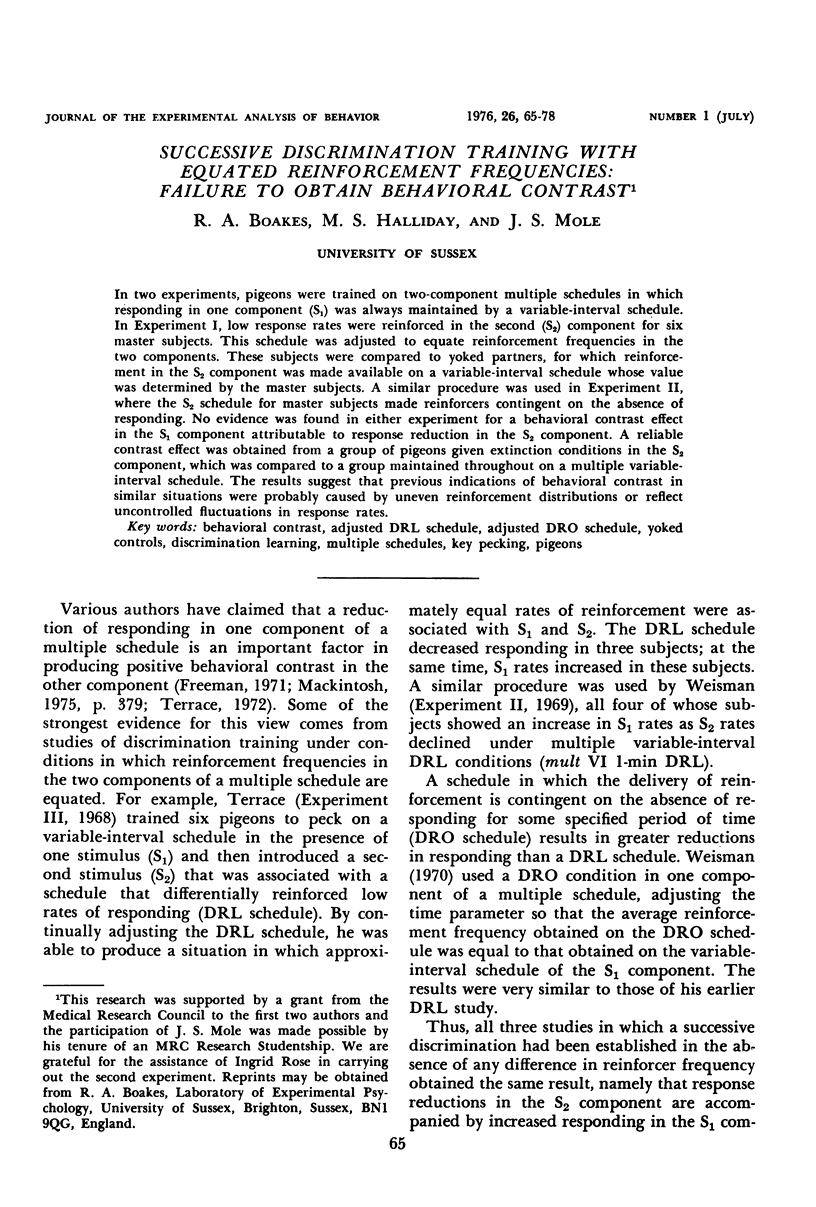Abstract
In two experiments, pigeons were trained on two-component multiple schedules in which responding in one component (S1) was always maintained by a variable-interval schedule. In Experiment I, low response rates were reinforced in the second (S2) component for six master subjects. This schedule was adjusted to equate reinforcement frequencies in the two components. These subjects were compared to yoked partners, for which reinforcement in the S2 component was made available on a variable-interval schedule whose value was determined by the master subjects. A similar procedure was used in Experiment II, where the S2 schedule for master subjects made reinforcers contingent on the absence of responding. No evidence was found in either experiment for a behavioral contrast effect in the S1 component attributable to response reduction in the S2 component. A reliable contrast effect was obtained from a group of pigeons given extinction conditions in the S2 component, which was compared to a group maintained throughout on a multiple variable-interval schedule. The results suggest that previous indications of behavioral contrast in similar situations were probably caused by uneven reinforcement distributions or reflect uncontrolled fluctuations in response rates.
Keywords: behavioral contrast, adjusted DRL schedule, adjusted DRO schedule, yoked controls, discrimination learning, multiple schedules, key pecking, pigeons
Full text
PDF













Selected References
These references are in PubMed. This may not be the complete list of references from this article.
- Bloomfield T. M. Behavioral contrast and relative reinforcement frequency in two multiple schedules. J Exp Anal Behav. 1967 Mar;10(2):151–158. doi: 10.1901/jeab.1967.10-151. [DOI] [PMC free article] [PubMed] [Google Scholar]
- Catania A. C., Reynolds G. S. A quantitative analysis of the responding maintained by interval schedules of reinforcement. J Exp Anal Behav. 1968 May;11(3 Suppl):327–383. doi: 10.1901/jeab.1968.11-s327. [DOI] [PMC free article] [PubMed] [Google Scholar]
- Dukhayyil A., Lyons J. E. The effect of overtraining on behavioral contrast and the peak-shift. J Exp Anal Behav. 1973 Sep;20(2):253–263. doi: 10.1901/jeab.1973.20-253. [DOI] [PMC free article] [PubMed] [Google Scholar]
- Gonzalez R. C., Champlin G. Positive behavioral contrast negative simultaneous contrast and their relation to frustration in pigeons. J Comp Physiol Psychol. 1974 Jul;87(1):173–187. doi: 10.1037/h0036575. [DOI] [PubMed] [Google Scholar]
- Halliday M. S., Boakes R. A. Behavioral contrast and response independent reinforcement. J Exp Anal Behav. 1971 Nov;16(3):429–434. doi: 10.1901/jeab.1971.16-429. [DOI] [PMC free article] [PubMed] [Google Scholar]
- Hearst E. Contrast and stimulus generalization following prolonged discrimination training. J Exp Anal Behav. 1971 May;15(3):355–363. doi: 10.1901/jeab.1971.15-355. [DOI] [PMC free article] [PubMed] [Google Scholar]
- Herrnstein R. J. On the law of effect. J Exp Anal Behav. 1970 Mar;13(2):243–266. doi: 10.1901/jeab.1970.13-243. [DOI] [PMC free article] [PubMed] [Google Scholar]
- Nevin J. A. Differential reinforcement and stimulus control of not responding. J Exp Anal Behav. 1968 Nov;11(6):715–726. doi: 10.1901/jeab.1968.11-715. [DOI] [PMC free article] [PubMed] [Google Scholar]
- REYNOLDS G. S. Behavioral contrast. J Exp Anal Behav. 1961 Jan;4:57–71. doi: 10.1901/jeab.1961.4-57. [DOI] [PMC free article] [PubMed] [Google Scholar]
- REYNOLDS G. S. Some limitations on behavioral contrast and induction during successive discrimination. J Exp Anal Behav. 1963 Jan;6:131–139. doi: 10.1901/jeab.1963.6-131. [DOI] [PMC free article] [PubMed] [Google Scholar]
- Richards R. W. Reinforcement delay: some effects on behavioral contrast. J Exp Anal Behav. 1972 May;17(3):381–394. doi: 10.1901/jeab.1972.17-381. [DOI] [PMC free article] [PubMed] [Google Scholar]
- Rilling M., Askew H. R., Ahlskog J. E., Kramer T. J. Aversive properties of the negative stimulus in a successive discrimination. J Exp Anal Behav. 1969 Nov;12(6):917–932. doi: 10.1901/jeab.1969.12-917. [DOI] [PMC free article] [PubMed] [Google Scholar]
- Selekman W. Behavioral contrast and inhibitory stimulus control as related to extended training. J Exp Anal Behav. 1973 Sep;20(2):245–252. doi: 10.1901/jeab.1973.20-245. [DOI] [PMC free article] [PubMed] [Google Scholar]
- Shimp C. P., Wheatley K. L. Matching to relative reinforcement frequency in multiple schedules with a short component duration. J Exp Anal Behav. 1971 Mar;15(2):205–210. doi: 10.1901/jeab.1971.15-205. [DOI] [PMC free article] [PubMed] [Google Scholar]
- Terrace H. S. Discrimination learning, the peak shift, and behavioral contrast. J Exp Anal Behav. 1968 Nov;11(6):727–741. doi: 10.1901/jeab.1968.11-727. [DOI] [PMC free article] [PubMed] [Google Scholar]
- Todorov J. C. Component duration and relative response rates in multiple schedules. J Exp Anal Behav. 1972 Jan;17(1):45–49. doi: 10.1901/jeab.1972.17-45. [DOI] [PMC free article] [PubMed] [Google Scholar]
- Weisman R. G. Factors influencing inhibitory stimulus control: differential reinforcement of other behavior during discrimination training. J Exp Anal Behav. 1970 Jul;14(1):87–91. doi: 10.1901/jeab.1970.14-87. [DOI] [PMC free article] [PubMed] [Google Scholar]
- Weisman R. G., Palmer J. A. Factors influencing inhibitory stimulus control: discrimination training and prior non-differential reinforcement. J Exp Anal Behav. 1969 Mar;12(2):229–237. doi: 10.1901/jeab.1969.12-229. [DOI] [PMC free article] [PubMed] [Google Scholar]
- Weisman R. G. Some determinants of inhibitory stimulus control. J Exp Anal Behav. 1969 May;12(3):443–450. doi: 10.1901/jeab.1969.12-443. [DOI] [PMC free article] [PubMed] [Google Scholar]


